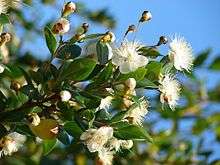Myrtus communis
| Myrtus communis | |
|---|---|
 | |
| Scientific classification | |
| Kingdom: | Plantae |
| Clade: | Angiosperms |
| Clade: | Eudicots |
| Clade: | Rosids |
| Order: | Myrtales |
| Family: | Myrtaceae |
| Genus: | Myrtus |
| Species: | M. communis |
| Binomial name | |
| Myrtus communis | |
| Synonyms[1] | |
|
List
| |
Myrtus communis, the common myrtle, is a species of flowering plant in the myrtle family Myrtaceae. It is an evergreen shrub native to southern Europe, north Africa, western Asia, Macaronesia, and the Indian Subcontinent, and also cultivated.[2]
It is one of the four species used by Jews in their religious rituals on the festival of Sukkot.
For uses, see Myrtus.
Description
The plant is an evergreen shrub or small tree, growing to 5 metres (16 ft) tall.[3] The leaves are 2–5 centimetres (0.79–1.97 in) long, with a fragrant essential oil.[3]
The flowers are white or tinged with pink, with five petals and many stamens that protrude from the flower.[3] The fruit is a berry, blue-black when ripe.[3]
This species,[4] and the more compact M. communis subsp. tarentina[5] have won the Royal Horticultural Society's Award of Garden Merit.[6]
 The plant
The plant- The plant, closeup
 Berries on the plant
Berries on the plant Berries macerated in alcohol to make Mirto liqueur
Berries macerated in alcohol to make Mirto liqueur
References
- ↑ The Plant List: A Working List of All Plant Species, retrieved 13 August 2016
- ↑ USDA GRIN Taxonomy, retrieved 13 August 2016
- 1 2 3 4 Cretan Flora: An illustrated guide to the flora of Crete, retrieved 13 August 2016
- ↑ "RHS Plantfinder - Myrtus communis". Retrieved 10 April 2018.
- ↑ "RHS Plantfinder - Myrtus communis subsp. tarentina". Retrieved 10 April 2018.
- ↑ "AGM Plants - Ornamental" (PDF). Royal Horticultural Society. July 2017. p. 64. Retrieved 10 April 2018.